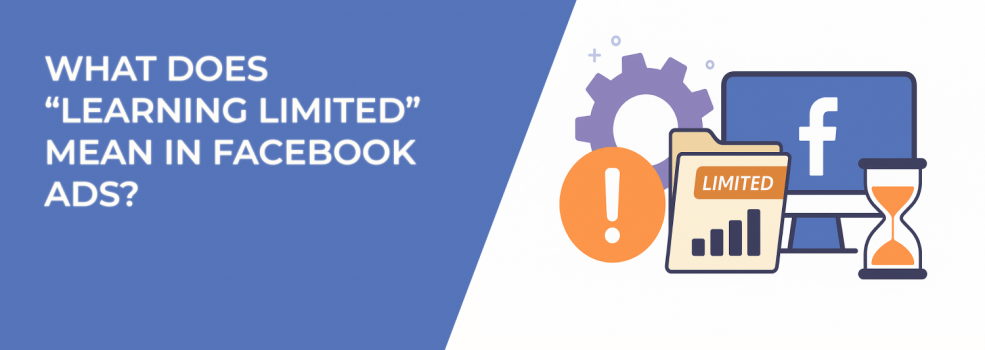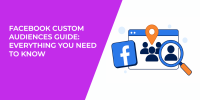When you launch a new Facebook ad set, it enters what Meta calls the learning phase. This is the period when the algorithm is testing, exploring, and figuring out how best to deliver your ads to the right people at the right time. But sometimes, your ad set never really makes it out of that phase. Instead, you might see a small warning in the Delivery column: Learning limited.
So what exactly does that mean, and why should you care? Let’s break it down in simple terms.
The Basics: What “Learning Limited” Really Means
If your ad set isn’t getting enough optimization events — the key actions you’ve chosen to measure success, such as purchases or leads — Facebook’s system can’t properly adjust delivery. That’s when your campaign gets flagged as learning limited.
It’s not a penalty. It’s a signal. The system is telling you that, with your current setup, it doesn’t have enough data to optimize performance.
Here’s the threshold you need to know about:
-
For most campaigns, you need around 50 optimization events per week after your last big edit.
-
For Shops ads, the benchmark is at least 17 purchases through your website and 5 through Meta within 7 days.
If your ad set falls short, it stays stuck in learning limited mode. This can hold back your performance and keep you from scaling. And while some campaigns can tolerate it, many advertisers find themselves frustrated when results stay unpredictable week after week.
For a broader overview of statuses and what they mean, check out Understanding Facebook Ad Statuses: Common Issues and How to Fix Them.
Why Your Ad Set Becomes Learning Limited
When you see that status appear, the first instinct is often to ask, “What went wrong?” The truth is, several different factors could be at play, and often it’s a combination rather than just one.
Some of the most common reasons include:
-
Small audience size: The system has too few people to deliver ads to.
-
Low budget: Not enough spend to generate the required optimization events.
-
Low bid or strict cost control: Your bid caps are keeping your ad from winning auctions.
-
High auction overlap: Too many ads competing against each other. (For a deeper dive on overlap mechanics and how to reduce it, see The Role of Audience Overlap in Facebook Ads Performance.)
-
Infrequent optimization event: Events like purchases may not happen often enough compared to something lighter, like add to cart.
-
Too many ads running at once: Splitting budget across multiple sets can dilute results.
Each of these challenges limits the system’s ability to gather the data it needs. For example, imagine running three small ad sets with the same audience but only $10 a day each. None of them will hit the event threshold, so all three stay learning limited. If instead, you had pooled that budget into a single ad set, you might have exited the learning phase within a week.
The bottom line: learning limited usually comes down to efficiency. If the system doesn’t have enough information to optimize, your ads can’t deliver at full strength.
What Happens If You Stay Stuck?
You might be tempted to ignore the warning. After all, your ads are still running. But there are consequences to staying stuck in learning limited that every advertiser should understand.
Here’s what you can expect:
-
Your delivery becomes unstable. Some days look great, others look flat.
-
Your CPA drifts higher because the system is guessing, not optimizing.
-
Your budget efficiency drops since the algorithm isn’t sure where to allocate spend.
This instability means your campaign can feel unpredictable. One week your ROAS looks healthy, and the next week it tanks. That rollercoaster is often a direct result of the system not having enough data to confidently optimize delivery.
So while you can technically keep running ads in learning limited, most marketers prefer to address the root cause so they can move toward consistent, scalable performance.
How to Fix Learning Limited Campaigns
The good news? You can take action. Once you understand what’s holding back your ad set, you can make adjustments that give the algorithm more breathing room.
Here are the most effective strategies to break free from learning limited:
1. Combine Ad Sets and Campaigns
If you’re spreading your budget across too many ad sets, each one gets starved of data. By consolidating them, you let Facebook collect optimization events more efficiently. This also prevents internal competition and overlap.
Think of it as giving the algorithm a clear signal rather than multiple faint signals. One strong campaign will usually outperform several weaker ones.
2. Expand Your Audience
Sometimes the problem is simply that your audience is too small. If the system runs out of people to show ads to, optimization slows down. Expanding interests, loosening demographic restrictions, or testing larger lookalikes can help.
A larger audience means more opportunities for the optimization event to occur, which helps your campaign exit learning limited faster. For targeting tactics that pair well with this step, check out How to Optimize Facebook Campaigns for Faster Learning Phase Exit.
3. Raise Your Budget
Budget is a huge driver of event volume. If you’re only spending $5 a day, it may be impossible to hit 50 events a week. Raising your budget — even modestly — can make a big difference.
Of course, this has to be balanced with your cost-per-result goals. But if you’re too conservative with spend, the campaign may never reach its potential. If you’re working with limited daily spend, these tactics help you squeeze more from every dollar: Campaign Optimization for Facebook Ads with Small Daily Budgets.
4. Adjust Your Bid or Cost Control
When your bid cap is too low, your ads lose auctions, which means fewer impressions and fewer chances for conversions. By loosening these controls, you allow more delivery, and the extra data helps the system learn faster.
If you’re worried about costs, try small increases rather than big jumps. Even a slight adjustment can improve delivery.
5. Change Your Optimization Event
Sometimes the bottleneck isn’t the budget or the audience — it’s the event itself. If you’re optimizing for purchases but only get a handful each week, the system struggles to gather data. Switching to a higher-frequency event like add to cart or view content can solve this.
This doesn’t mean you’re giving up on purchases. You can always optimize for deeper events later once your campaign stabilizes. For more techniques that speed up stabilization without sacrificing quality, see The Science of Scaling Facebook Ads Without Killing Performance.
Should You Always Fix It?
Interestingly, not every campaign needs to exit learning limited. In some cases, the status is acceptable. For example, if you’re targeting a very niche audience or running a campaign with a naturally small number of conversions, you may still be satisfied with results even if the system labels it as limited.
However, most advertisers will benefit from making at least one of the changes above. If your CPA is creeping upward, or if your delivery feels unpredictable, it’s a sign that the algorithm doesn’t have what it needs. Addressing that will almost always lead to more stable performance and better use of your budget.
Final Thoughts
“Learning limited” in Facebook Ads isn’t a death sentence, but it’s not something to ignore either. It’s a signal that your ad set doesn’t have enough optimization events to fully stabilize delivery. And when that happens, you lose the consistency that makes Meta’s system so powerful.
The best approach is to treat it like an early warning system. Check your budget, audience size, bids, and optimization events.
If something’s holding you back, make the adjustments. A few smart tweaks can help your campaigns exit learning limited and start delivering the kind of steady, scalable results that make Facebook Ads worth the investment.

